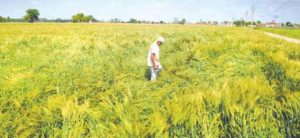 Mandeep Singh Grewal, a young marginal farmer of village Lalton Kalan near Ludhiana, apprehends loss of wheat yield roughly by 4-5 quintals during the ongoing rabi season due to unseasonal heavy rainfall which lashed Punjab accompanied by hailstorms at various places. For the marginal and small famers like him across the state, the loss of even a few quintals means much for them and they look up to the state government to help them out by way of compensation. Last season, his per acre yield was about 20 quintals.
Mandeep Singh Grewal, a young marginal farmer of village Lalton Kalan near Ludhiana, apprehends loss of wheat yield roughly by 4-5 quintals during the ongoing rabi season due to unseasonal heavy rainfall which lashed Punjab accompanied by hailstorms at various places. For the marginal and small famers like him across the state, the loss of even a few quintals means much for them and they look up to the state government to help them out by way of compensation. Last season, his per acre yield was about 20 quintals.
Though the Indian Meterological Department (IMD) has predicted dry weather conditions over the major part of this week, the state revenue authorities have got into action seeking field reports as part of the special Khasra Girdawari ordered by the Chief Minister Captain Amarinder Singh to assess the damage. Seized of the urgency to act swiftly before the Opposition parties and farmers organization could make it an issue, the government has directed all the Deputy Commissioners (DCs) to submit the preliminary reports at the earliest so as to enable the Revenue Department to initiate the disbursement of relief. The administrative and revenue officials have been directed to visit the affected areas extensively to conduct on the spot assessment.
At this stage when the assessment exercise is on to quantify the extent of damage, the experts at Punjab Agricultural University (PAU), Ludhiana and the officials of the state agriculture department are keeping their fingers crossed about the possible hit the production may take. In rabi season 2018-19, it was record bumper wheat production of 182 lakh tonnes in the state. The per acre average yield was about 20 quintals.
Of the total cultivated area, the area under wheat was 82 per cent. Dr Joginder Singh, a former head, Department of Economics, PAU has observed that weather holds key to matching the previous year’s production record. “On the positive side, the average yield per acre may increase owing to drop in temperature but it remains to be seen whether it would balance the quantum of damage caused by cumulative effect of rainfall, gusty winds and hailstorms,” he said.
The experts at the PAU are of the view that at the prevailing grain-filling stage of the crop, heavy rainfall accompanied by gusty winds will sure damage the yield. Moreover, the flattening of the crop caused by the above twin factors is likely to cause problem in mechanical harvesting and ultimately affect the production.
Given the fact that winter rainfall in the region is usually caused by western disturbances, the agro meteorologists have observed the frequency of adverse weather condition is higher this time. The damage assessment in the form of special Girdawari ordered already by the Chief Minister has got prolonged due to unstable weather behavior. The rainfall, though easily predictable, came in spells. The hailstorms, comparatively more pervasive this time, have added to the farmers’ misfortune as the damage caused by them is irretrievable as compared to rainfall.
Given the behavior of weather so far, the experts have also observed that the damage may not be uniform everywhere. It may vary from field to field. And extent of overall damage will depend on the length and intensity of the weather conditions in coming days as their cycle is not over yet. The recovery time may also increase if the cold weather continues.
letters@tehelka.com













